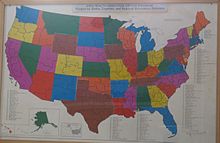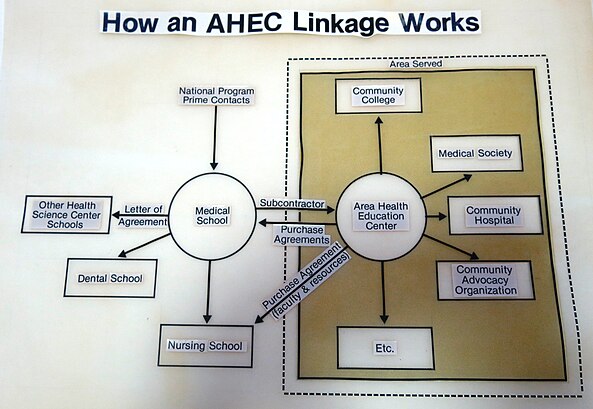A physician assistant or physician associate (PA) is a type of mid-level health care provider. In North America PAs may diagnose illnesses, develop and manage treatment plans, prescribe medications, and serve as a principal healthcare provider. PAs are required in many states to have a direct agreement with a physician.

The Medical University of South Carolina (MUSC) is a public medical school in Charleston, South Carolina. It opened in 1824 as a small private college aimed at training physicians and has since established hospitals and medical facilities across the state. It is one of the oldest continually operating schools of medicine in the United States and the oldest in the Deep South.
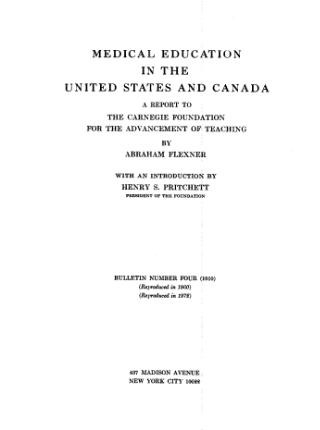
The Flexner Report is a book-length landmark report of medical education in the United States and Canada, written by Abraham Flexner and published in 1910 under the aegis of the Carnegie Foundation. Many aspects of the present-day American medical profession stem from the Flexner Report and its aftermath. The Flexner report has been criticized for introducing policies that encouraged systemic racism.

Abraham Flexner was an American educator, best known for his role in the 20th century reform of medical and higher education in the United States and Canada.

UConn Health is the branch of the University of Connecticut that oversees clinical care, advanced biomedical research, and academic education in medicine. The main branch is located in Farmington, Connecticut, in the US. It includes a teaching hospital, the UConn School of Medicine, School of Dental Medicine, and Graduate School. Other community care satellite locations exist in Avon, Canton, East Hartford, Putnam, Simsbury, Southington, Storrs, Torrington, West Hartford, and Willimantic, including two urgent cares in both Storrs and Canton. The university owns and operates many smaller clinics around the state that contain UConn Medical Group, UConn Health Partners, University Dentists and research facilities. Andrew Agwunobi stepped down as the CEO of UConn Health in February 2022 after serving since 2014 for a private-sector job. Bruce Liang is UConn Heath's interim CEO and remains dean of the UConn School of Medicine.
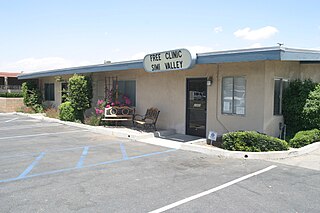
A free clinic or walk in clinic is a health care facility in the United States offering services to economically disadvantaged individuals for free or at a nominal cost. The need for such a clinic arises in societies where there is no universal healthcare, and therefore a social safety net has arisen in its place. Core staff members may hold full-time paid positions, however, most of the staff a patient will encounter are volunteers drawn from the local medical community.
The University of North Texas Health Science Center is a public academic health science center in Fort Worth, Texas. It is part of the University of North Texas System and was founded in 1966 as the Texas College of Osteopathic Medicine, with its first cohort admitted in 1970. UNT Health Science Center consists of five graduate schools with a total enrollment of 2,329 students (2020–21).
Allied health professions are health care professions distinct from optometry, dentistry, nursing, medicine, and pharmacy. They provide a range of diagnostic, technical, therapeutic, and support services in connection with health care.

The UCLA School of Dentistry is the dental school of the University of California, Los Angeles (UCLA) located in the Center for Health Sciences building in the Westwood neighborhood of Los Angeles, California, United States. The school has several educational and training programs, conducts oral and dental health research, and offers affordable dental care at three locations: Westwood, Venice, and Inglewood. The school also participates in several outreach endeavors, including numerous health fairs during the year, STEM pipeline programs and provides dental care for underserved populations in the region. The School of Dentistry is considered among the nation's best research-intensive dental schools.
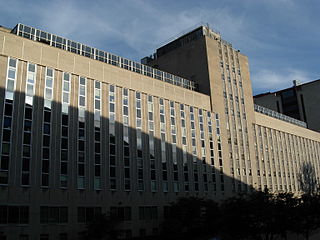
The University of Pittsburgh School of Medicine is a medical school of the University of Pittsburgh, located in Pittsburgh, Pennsylvania. The School of Medicine, also known as Pitt Med, is consistently ranked as a "Top Medical School" by U.S. News & World Report in both research and primary care. It was ranked 13th in the category of research and 14th in primary care by U.S. News for 2020 and is separately ranked 17th in the Academic Ranking of World Universities list of best medical schools in the world. The school encompasses both a medical program, offering the doctor of medicine, and graduate programs, offering doctor of philosophy and master's degrees in several areas of biomedical science, clinical research, medical education, and medical informatics.
A health professional, healthcare professional, or healthcare worker is a provider of health care treatment and advice based on formal training and experience. The field includes those who work as a nurse, physician, physician assistant, registered dietitian, veterinarian, veterinary technician, optometrist, pharmacist, pharmacy technician, medical assistant, physical therapist, occupational therapist, dentist, midwife, psychologist, or who perform services in allied health professions. Experts in public health and community health are also health professionals.

Narrative Medicine is the discipline of applying the skills used in analyzing literature to interviewing patients. The premise of narrative medicine is that how a patient speaks about his or her illness or complaint is analogous to how literature offers a plot with characters and is filled with metaphors, and that becoming conversant with the elements of literature facilitates understanding the stories that patients bring. Narrative Medicine is a diagnostic and comprehensive approach that utilizes patients' narratives in clinical practice, research, and education to promote healing. Beyond attempts to reach accurate diagnoses, it aims to address the relational and psychological dimensions that occur in tandem with physical illness. Narrative medicine aims not only to validate the experience of the patient, it also encourages creativity and self-reflection in the physician.
The Northwest Area Health Education Center of Wake Forest School of Medicine is one of nine regional Area Health Education Centers (AHECs) of the North Carolina Area Health Education Centers program. Northwest AHEC is an educational outreach center and training program designed to better the health of the public in its 17-county region. It does this by working to increase the number of health and human service professionals, while also trying to improve their representation throughout the region and their skill quality—especially those who have chosen to work in primary care settings —through several diverse community groups and partnerships with educational institutions.
Commission on Accreditation of Allied Health Education Programs,, is an accreditation agency for postsecondary education programs in 30 health science fields.
The National AHEC Organization (NAO) is the professional association of Area Health Education Centers (AHECs) in the United States. AHECs are regional organizations associated with The National AHEC Program. AHECs work in designated regions through community and academic partnerships to advance the availability of health care and health care education, focusing on rural and medically underserved areas. According to the NAO, approximately 120 medical schools and 600 nursing and allied health schools work with the AHEC system. AHECs affiliated with the NAO collaborate to educate, share resources, and strengthen local and national partnerships.

A healthcare center, health center, or community health center is one of a network of clinics staffed by a group of general practitioners and nurses providing healthcare services to people in a certain area. Typical services covered are family practice and dental care, but some clinics have expanded greatly and can include internal medicine, pediatric, women’s care, family planning, pharmacy, optometry, laboratory testing, and more. In countries with universal healthcare, most people use the healthcare centers. In countries without universal healthcare, the clients include the uninsured, underinsured, low-income or those living in areas where little access to primary health care is available. In the Central and East Europe, bigger health centers are commonly called policlinics.
The Greensboro Area Health Education Center is one of nine regional centers affiliated with the North Carolina Area Health Education Centers Program and is administered by the University of North Carolina School of Medicine at Chapel Hill, North Carolina. Greensboro AHEC serves healthcare professionals in an eight-county region including Alamance, Caswell, Chatham, Guilford, Montgomery, Orange, Randolph and Rockingham by providing information resources to both practicing healthcare professionals and students.
The North Carolina Area Health Education Centers Program provides the central leadership and support for all of the regional NC Area Health Education Centers (AHECs). It is located on the campus of the University of North Carolina School of Medicine in Chapel Hill, NC.
Throughout the United States, many rural communities are faced with severe healthcare workforce shortage issues. These regions often consist of a larger percentage of medically underserved individuals, in conjunction with fewer physicians, nurses, and other healthcare workers. The shortage of healthcare workers negatively impacts the quality of medical care due to decreased access to health services as well as an increase in workload placed on providers. Healthcare systems in rural communities generally have fewer personnel and infrastructure, creating substantial healthcare disparities among the United States population. Rural communities tend to have a higher incidence of chronic diseases, infant and maternal morbidity, and occupational injuries. These communities also consist of individuals who tend to be older and have a lower socioeconomic status, which directly relates to the high rate of uninsured individuals. Ethnic minorities are also increasing in number throughout rural areas, further adding to the size of healthcare disparities.
The Bureau of Health Workforce is a part of the Health Resources and Services Administration (HRSA), of the United States Department of Health and Human Services. HRSA programs train health care professionals and place them where they are needed most. Grants support scholarship and loan repayment programs at colleges and universities to meet critical workforce shortages and promote diversity within the health professions.
